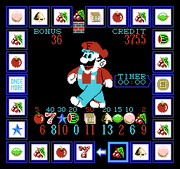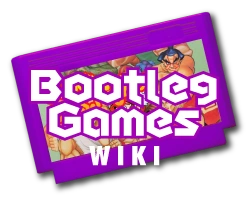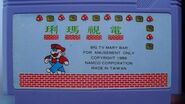(i just edited some of the trivia) Tags: Visual edit apiedit |
mNo edit summary Tag: Source edit |
||
| (40 intermediate revisions by 16 users not shown) | |||
| Line 1: | Line 1: | ||
| − | {{ |
+ | {{Infobox game |
| − | | |
+ | |name = Dian Shi Ma Li |
| − | | |
+ | |image = Dian Shi Ma Li Title screen.png |
| ⚫ | |||
| − | | imagewidth = 250 |
||
| ⚫ | |||
| ⚫ | |||
| ⚫ | |||
| ⚫ | |||
| + | |console = Famicom |
||
| ⚫ | |||
| − | | |
+ | |date = 1989 |
| − | | |
+ | |engine = Unknown |
| − | | |
+ | |sound = |
| − | | |
+ | |alt = ''Big TV Mary Bar'' |
| − | | alt = Big TV Mary Bar |
||
}} |
}} |
||
| − | '''''Dian Shi Ma Li''''' ( |
+ | '''''Dian Shi Ma Li''''' (Traditional Chinese:電視瑪琍 / Simplified Chinese: 电视玛琍, literally "TV Mari", official English title '''''Big TV Mary Bar''''') is a Famicom game based on the Taiwanese "''[[Xiao Ma Li]]''" gambling machines. It was published by "[[Fiver Firm|Namco Corporation]]" in 1989 and was likely developed by the same team as several [[Bit Corp.]] games based on the quality and its similarity to ''Jackpot''. It is well-known for featuring a poorly pixelated Mario with an F on his cap and the phrase "Push Start To Rich". This game is very popular in China. |
| ⚫ | |||
| ⚫ | |||
| ⚫ | |||
| ⚫ | If the pointer lands on the coin item then the phrase "Push Start To Rich" flashes near the bottom of the screen and the timer (on the right of the gameplay image) is set to a certain amount of seconds, where tapping the start button makes |
||
| + | [[File:Dian Shi Ma Li - Gameplay.png|left|thumb|''Dian Shi Ma Li''<nowiki>'</nowiki>s gameplay.]] |
||
| ⚫ | |||
| ⚫ | The objective of the game is to gain as many credits as possible, mainly through betting on the numerous icons you'd find on a slot machine. The control system is awkward and like several Atari 2600 games such as [[Wikipedia:Raiders of the Lost Ark (video game)|''Raiders of the Lost Ark'']], requires two controllers to play properly. Each button on the first controller (including the D-pad) is assigned to putting bet on a certain icon (i.e. The A button puts bets on the cherry icon) with the exception of Bar, which is done by pressing A on the second controller. Pressing B on the second controller will start the machine, which can also be done by betting 180 credits. Winning a bet triggers a primitive rendition of Beethoven's "Ode to Joy" and the character hitting a block. If the item that the pointer landed on appears above the hit brick, the amount of credits won will be doubled. During or after this, pressing down on the D-pad will start the next round, while pressing up starts a bonus card game where you have to guess whether the next card will be high or low, with 8 and lower being small and 9 and above being high. The player can gain double the amount of money they won if they guess right. |
||
| ⚫ | |||
| − | *There is a cheat.Pressing start while receiving bonus gives you more extra bonus.As it says when you hit the coin. |
||
| ⚫ | |||
| ⚫ | |||
| ⚫ | |||
| ⚫ | |||
| ⚫ | |||
| ⚫ | |||
| ⚫ | |||
| − | **Fortran being referred to as "Grand Dad" originates from a [https://youtu.be/v2UzROUj0yE?t=54m52s popular stream] where Joel from Vinesauce plays the Flintstones hack, ''Grand Dad 7. GRAND DAD From Grand Dad 7 is a sprite edit of fortran''. |
||
| ⚫ | If the pointer lands on the coin item then the phrase "Push Start To Rich" flashes near the bottom of the screen and the timer (on the right of the gameplay image) is set to a certain amount of seconds, where tapping the start button makes the player jump into the block, gaining 10 credits every time he does this. |
||
| ⚫ | |||
| + | |||
| − | <gallery captionalign="left"> |
||
| ⚫ | |||
| − | Dian_Shi_Ma_Li.jpg|Cartridge |
||
| ⚫ | |||
| ⚫ | |||
| ⚫ | |||
| + | *Pressing start while you're hitting the block will result in a larger bonus |
||
| ⚫ | |||
| ⚫ | |||
| ⚫ | *Unused tiles within the game reveal the text "Fortran" which is assumed to be either the name of the strange Mario ripoff or the name of the development team.<ref name="tcrf">[https://tcrf.net/Dian_Shi_Ma_Li Dian Shi Ma Li on The Cutting Room Floor]</ref> The name "Fortran" is generally assigned to the Mario sprite on the internet. |
||
| ⚫ | |||
| ⚫ | |||
| + | **The F on his cap is either a reference to Fortran or the publisher, Fiver Firm. |
||
| ⚫ | |||
| + | *The game's ROM contains hidden statistics and dip switch menu screens accessible by hacking, although only SW3 is adjustable in the latter. What changes each SW3 parameter does has not been tested.<ref name=tcrf/> |
||
| + | |||
| ⚫ | |||
| + | <gallery> |
||
| + | Dian Shi Ma Li - Cartridge.jpg|Cartridge. |
||
| ⚫ | |||
</gallery> |
</gallery> |
||
| + | |||
| + | == Video == |
||
| + | <gallery> |
||
| + | Dian Shi Ma Li (Famicom) - Gameplay|Gameplay. |
||
| + | </gallery> |
||
| + | |||
| + | == References == |
||
| + | {{reflist}} |
||
| + | |||
[[Category:Games]] |
[[Category:Games]] |
||
[[Category:Famicom/NES games]] |
[[Category:Famicom/NES games]] |
||
| + | [[Category:Gambling games]] |
||
| + | [[Category:1989 video games]] |
||
[[Category:Mario games]] |
[[Category:Mario games]] |
||
Latest revision as of 00:42, 21 July 2023
Dian Shi Ma Li (Traditional Chinese:電視瑪琍 / Simplified Chinese: 电视玛琍, literally "TV Mari", official English title Big TV Mary Bar) is a Famicom game based on the Taiwanese "Xiao Ma Li" gambling machines. It was published by "Namco Corporation" in 1989 and was likely developed by the same team as several Bit Corp. games based on the quality and its similarity to Jackpot. It is well-known for featuring a poorly pixelated Mario with an F on his cap and the phrase "Push Start To Rich". This game is very popular in China.
Overview

Dian Shi Ma Li's gameplay.
The objective of the game is to gain as many credits as possible, mainly through betting on the numerous icons you'd find on a slot machine. The control system is awkward and like several Atari 2600 games such as Raiders of the Lost Ark, requires two controllers to play properly. Each button on the first controller (including the D-pad) is assigned to putting bet on a certain icon (i.e. The A button puts bets on the cherry icon) with the exception of Bar, which is done by pressing A on the second controller. Pressing B on the second controller will start the machine, which can also be done by betting 180 credits. Winning a bet triggers a primitive rendition of Beethoven's "Ode to Joy" and the character hitting a block. If the item that the pointer landed on appears above the hit brick, the amount of credits won will be doubled. During or after this, pressing down on the D-pad will start the next round, while pressing up starts a bonus card game where you have to guess whether the next card will be high or low, with 8 and lower being small and 9 and above being high. The player can gain double the amount of money they won if they guess right.
If the pointer lands on the coin item then the phrase "Push Start To Rich" flashes near the bottom of the screen and the timer (on the right of the gameplay image) is set to a certain amount of seconds, where tapping the start button makes the player jump into the block, gaining 10 credits every time he does this.
Trivia
- The original release claims to be called "Big TV Mary Bar", made by Namco Corporation in Taiwan in 1989. It also includes the message "For Amusement only", which appears in Jackpot, released by Bit Corp.
- A pirated version also exists version which removes the text on the title screen.
- Pressing start while you're hitting the block will result in a larger bonus
- The main board looks somewhat similar to the one from Press Your Luck.
- Idea-Tek released another Famicom adaptation of Xiao Ma Li, simply titled Xiao Ma Li.
- Unused tiles within the game reveal the text "Fortran" which is assumed to be either the name of the strange Mario ripoff or the name of the development team.[1] The name "Fortran" is generally assigned to the Mario sprite on the internet.
- An "F" logo appears alongside the text, which can also be found in the Bit Corp games Jackpot and Sheng Hen Pao (Strip Poker).
- Fortran is one of the earliest programming languages that was "portable", or one that could be used on multiple machines. Fortran could also be a misspelling of "Fortune".
- The F on his cap is either a reference to Fortran or the publisher, Fiver Firm.
- Fortran appears on the title screen of Mario IV, Mario Fighter III, and 7 Grand Dad with edited colors and the Chinese character "王" (Wang, meaning King) instead of an F.
- The game's ROM contains hidden statistics and dip switch menu screens accessible by hacking, although only SW3 is adjustable in the latter. What changes each SW3 parameter does has not been tested.[1]



